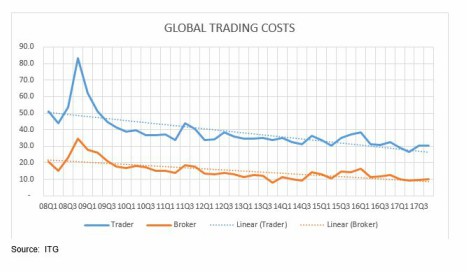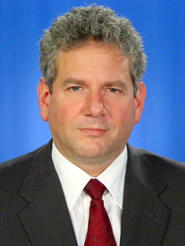Ten years ago the debate between fragmentation and centralization was all the rage on Wall Street. And it still is, to a degree, today.
Is it better to have a marketplace with over 40 trading venues, including myriad dark ones? Or should the market trade on a handful of large public lit exchanges for all to see? What serves the buy-side and its incessant need for natural liquidity?
Is the market really all that fragmented? And moreover, has the market suffered for it.

Ian Domowitz, Vice Chairman of ITG, told Traders Magazine that evidence of market fragmentation can be found almost anywhere these days.
Even now, we are witnessing the birth of over 100 systematic internalisers in the EU as a result of new dark pool rules, Domowitz began.
But fragmentation by itself does not make trading more expensive, he continued.
I measure relative health of trading markets in terms of transactions costs. The figure below shows cost incurred by brokers (in basis points, not including any delay costs of institutions) and for the institutions themselves, Domowitz said. The time period is from Q1 2008 through Q3 2017. This period covers a high, and growing, fragmentation environment. Despite that, transaction costs were falling in the post-crisis era, as they were from 2002-2007. And since 2012 broker costs have been generally flat for each region and globally.

The link between fragmentation and dark pool activity is a question related to the industrial organization of markets. As Domowitz sees it, there were very few competitors in the crossing space until thirteen years ago. The barrier was the cost of accumulating and maintaining a sufficient liquidity pool to enable trade execution in an anonymous and confidential environment. This cost defeated even early attempts at exchange-operated dark pools. Hardware and software are cheap; liquidity remains an expensive commodity.
With the arrival of algorithmic trading, the intelligence of algorithms focused on the search for liquidity. Liquidity aggregators were born, and it no longer was necessary to build liquidity pools on the same scale as before, he continued. The cost of crossing mechanisms dropped sharply, and the number of dark pools exploded.
Thus, the competitive story is not over, Domowitz said.
The recent advent of exchange-operated dark pools is evidence of a desire to (re)consolidate liquidity at the exchange level. There have been eight such efforts in the past few years. Domowitz said the phenomenon should not be looked upon as an increase in fragmentation, per se.

Consolidation of liquidity has been a primary argument by registered exchanges, in support of their structure and against fragmentation, he continued. Exchange-operated crossing operations are simply responsive to demands for a lack of pre-trade transparency on the part of the global trading community.
Bill Harts, an industry expert and founding member of the Modern Markets Initiative, told Traders Magazine that its been 10 years since this story ran, and the issue is still hotly contested: fragmentation vs competition.Harts prefers this comparison as opposed to the original story that frames the debate as fragmentation vs centralization.
The results speak volumes: brokers have developed sophisticated algos to knit together fragmented liquidity and intense competition between markets has greatly benefitted investors who now have access to the most efficient and fair trading environment the world has ever known, Harts said.
But many industry participants see gathering clouds on the fragmentation horizon, he continued In particular, Harts said that exchanges have come to wield their power to charge traders high fees for associated services such as market data and data communications, without meaningful recourse short of not trading on a particular venue-something that would surely harm best execution for the average investor.
And while competition should fix the problem, the exchanges are focused on providing high returns on equity to their non-participant shareholders, limiting their willingness to do so, he added. Going forward, I see new competition entering the exchange landscape as a means to reign in these costs while ensuring best execution for investors.
This article originally appeared in the February 2008 edition of Traders Magazine
The Age-Old Debate: Centralization vs. Fragmentation
By Nina Mehta
Competition between orders? Or competition between marketplaces? Which is better? The venerable question was taken up recently at a forum focusing on alternative trading systems put on by NYSE Euronext. (The NYSE’s own point-in-time crossing system, MatchPoint, launched last month.)
On the panel, two industry veterans debated the pros and cons of a U.S. stock market fragmented by dozens of individual venues, including exchanges, ECNs and ATSs.
For the debate, Joe Gawronski, president and chief operating officer of Rosenblatt Securities, an institutional agency broker, took up the cudgels for centralization, or competition between orders. Brett Redfearn, a senior managing director in the institutional equities division at Bear Stearns, argued on behalf of fragmentation, or competition between marketplaces. The debate was moderated by Robert Schwartz, a finance professor at Baruch College in New York.
On fragmentation:
Redfearn described the centralization vs. fragmentation debate as a choice between stagnation and competition. In his view, “competition and fragmentation are clearly winning.” He noted that innovation spawned by competition–in the form of venues such as Arca and INET, as well as dark liquidity–has become “absolutely critical” to the evolution of the equities market.
Gawronski observed that the “goal of equities markets is to put buyers and sellers together at the right price” and that order interaction is “central to coming to the right price.” Since orders “can’t be in two places at once,” he said, fragmentation means that many orders, therefore, can’t interact.
On Regulation NMS’s impact on fragmentation:
Redfearn pointed out that Reg NMS led to the current market fragmentation. First, the prospect of Reg NMS caused the NYSE to become more electronic, enabling other markets to compete with the Big Board. Second, Reg NMS’s broadened trade-through rule provided “a level of protection” for displayed market centers that made it possible for them to compete with the bigger guns. However, he noted, BATS and Direct Edge, rather than the regionals, grabbed that additional market share in equities.
Gawronski said about Reg NMS: “I don’t think it achieved its goals.” He observed that traders don’t want to post their orders out loud. In addition, the fragmentation and growth of dark liquidity means that “as a broker, you can never know you’re getting best execution.”
On a potential increase in fragmentation:
Redfearn observed that block-trading venues, upstairs desks and crossing entities will never disappear, because the need to source liquidity will always be present. Although he conceded that there are “too many” displayed markets, he noted that competition has done away with the olden days of a single market having 80 percent market share. Now, he said, any venue will be hard-pressed to get more than 30 percent.
Gawronski said more fragmentation is likely, noting that liquidity is increasingly being hidden. In addition, “rebate seekers” and algo traders are breaking up orders, making the market more fragmented.
On the multiplicity of dark pools:
Redfearn argued that algorithms “pull together” fragmented liquidity and prices in the market, providing access as well as a vehicle for price discovery. He added that algos that tap into dark pools cater to customer demand for hidden, anonymous executions with minimal market impact.
Gawronski replied that algos are “weak substitutes for centralization” and wondered how many of the current 37 or so dark pools OMSs reach. Liquidnet, for instance, is closed to brokers, while ITG’s POSIT and Pipeline don’t allow buysiders to access their pools through broker algos. He added that “cheaper fees” rather than “better executions” may also attract some orders.
On the limits of their respective positions:
Redfearn observed that the “ongoing, endless and almost inevitable debate between competition and centralization” would surely continue. He also noted that, in U.S. equities, NYSE Euronext now has the NYSE floor, Hybrid, Arca, MatchPoint and New York’s joint venture with BIDS. To the extent that those entities can interact and create some centralization, he said, “that would be a good thing.”
Gawronski noted that “conceptually, a centralized market is orderly, but absolute power can corrupt.” What’s best, he said, is a “centralized market kept honest and innovative.”






